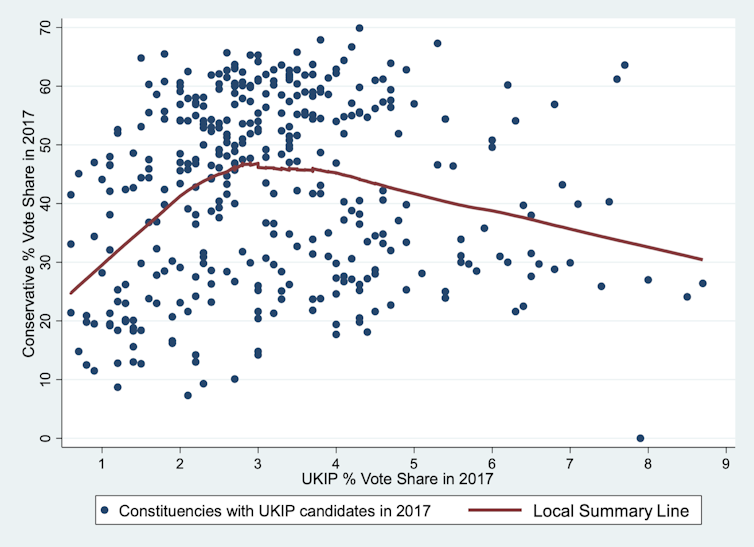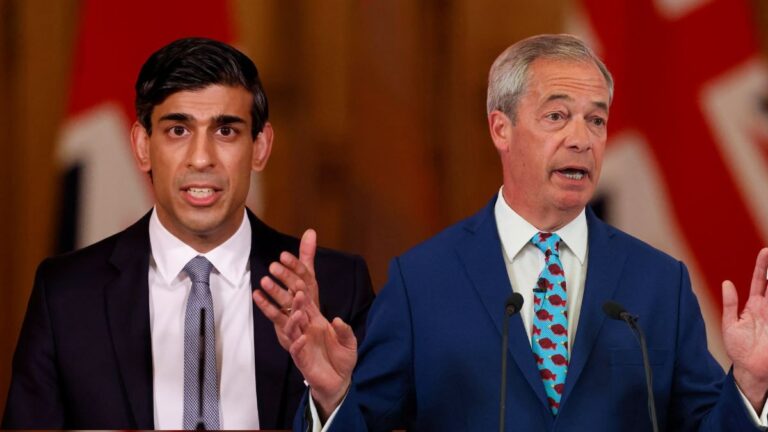Nigel Farage’s Reform UK Party has overtaken Rishi Sunak’s Conservative Party in opinion polls ahead of the UK general election.
A YouGov poll has put Reform UK ahead of the Conservatives for the first time. After weeks of a nasty election campaign, the Conservatives are narrowly ahead on 18% support, with Reform UK on 19%. In the same poll, Labour was on 37% and the Liberal Democrats on 14%.
Understanding the nuances of opinion polls
While this news makes headlines, it actually means that the Conservatives and Reform parties are roughly neck and neck in the polls, as all polls are subject to error, and a typical poll has a margin of error of plus or minus 3 percentage points.
This happens because even proper probability polls can have different results than surveys of the entire electorate. If Reform reaches 21% voting intention and the Conservatives only 18%, statistical theory suggests there is a 95% chance that Nigel Farage’s party will actually lead the country.
The Nigel Farage factor
Still, Mr Farage’s sudden appointment as leader of the Reform Party and his decision to stand as its candidate in Clacton have clearly boosted support for the party, and Mr Farage has been given a boost by Rishi Sunak’s decision to leave the Normandy landings ceremony early, offering an opportunity to attack the Prime Minister for his lack of patriotism.
The fact that the Reform Party has overtaken the Conservatives in at least one opinion poll raises the question of whether the party can beat them in the upcoming general election – highly unlikely in terms of seats, but perhaps in terms of vote share.
Reformist victories over conservatives in the past
It is important to remember that the Reform Party, in its previous existence as the Brexit Party, had already defeated the Conservative Party in a UK national election – this time in the now largely forgotten European Parliament elections of May 2019. The Reform Party actually temporarily disrupted the UK party system.
In the European Parliament, the Brexit Party came out on top with 29 seats, followed by the Liberal Democrats with 16. Labour won 10 seats and the Conservatives 4. As the Conservatives’ support plummeted, the Greens ended up with three more seats than the Conservatives.
This was at the height of the chaos over Brexit and Prime Minister Theresa May’s failure to reach a deal with the EU in the House of Commons. My colleagues and I analyzed the election in our book Brexit Britain and concluded that “the national mood was so bad that many voters – both Leave and Remain – were inclined to ‘slam’ the main parties.”
Of course, there are big differences between European elections and general elections. Voter turnout in European elections is always low, and the 2019 European elections were heavily focused on Brexit. In contrast, opinion polls reveal that only 13% of the public now consider Brexit to be the most important issue. Brexit has faded considerably as an issue.
But we all recognise that the national mood is once again very bad and the tendency to ‘hurt the major parties’ weighs heavily on our shoulders.
Reform Party supporters
Survey analysis conducted during the European elections showed that the Brexit Party had strong support among older voters, less educated voters, those on lower incomes, men and working-class voters who were strongly in favour of leaving the EU, liked Farage and disliked Jeremy Corbyn and May. Many of them sympathised with the Brexit Party, even though it was a very new political brand (only founded in 2018).
Brexit supporters are also anti-establishment, opposed to excessive inequality in the UK and dislike big business.
A YouGov poll on 2024 voting intentions found that Reform Party voters have very similar characteristics to Brexit Party voters in 2019. For example, the survey found no support for Reform among 18-24 year olds, only older voters. Support for Reform is also significantly higher among working class people than middle class people.
The most important question about whether to support Reform in the 2024 election is how it will affect the Conservative vote. Unfortunately, data from the 2019 election is not useful here because Farage demoted Reform candidates in Conservative constituencies in favor of pro-Brexit incumbents. Reform only fielded 275 candidates nationwide after all, so the 2019 election results cannot be used as a model for this year’s potential election.
UKIP performance an indicator of Reform Party’s chances of victory
We can, however, look at UKIP’s performance in the 2017 general election. Although UKIP still exists as a political party, the vast majority of its leadership, candidates and voters moved to the Brexit Party when it was formed in 2018, and then to the Reform Party. The move was so large that UKIP can essentially be seen as an earlier version of the Reform Party.
In 2017, UKIP fielded 378 candidates, equivalent to nearly 60% of the seats in the Westminster Parliament. This graph shows the relationship between the Conservative and UKIP vote shares in those seats.
Conservative and UKIP vote shares in the 2017 UK general election:

P. WhiteleyCC BY
Each point on the graph is a constituency, and the summary line measures the relationship between the vote shares of the two parties in similar constituencies – this is not the same as fitting a summary line to every constituency, but it captures how the relationship changed as UKIP gained more support across the country.
This reveals a very interesting fact: both the Conservative and UKIP vote shares rose when UKIP’s support remained below around 4% – in fact the Conservatives and UKIP were allies in these constituencies, and both parties were taking votes from the other party.
However, the situation changed dramatically when UKIP began winning votes above the 4% threshold, and the two parties then became rivals, with UKIP growing in power at the expense of the Conservatives.
The reason for this has to do with the support of the Leave vote in the 2016 Brexit referendum, which was only weakly correlated with Conservative votes in 2017 (0.30), but very strongly correlated with UKIP votes (0.69). This means that many voters in strongly Leave constituencies had more confidence in UKIP and Farage to get the job done than the Conservatives and May.
What does it mean?
If Reform Party voters behave in this election like UKIP voters did in 2017, it would see a surge in support for the party and make it a formidable rival to the Conservatives in almost every constituency it contests.
Admittedly, Brexit is no longer as salient an issue as it was back then, and there is now widespread “regret” among voters. But a YouGov survey conducted last year found that about a third of voters still support Brexit. Combined with a sharp drop in approval ratings for the government, it’s easy to imagine how disgruntled Conservative Leave voters could easily switch their vote to the Reform Party.
Ironically, this would lead to victories for both Labour and the Liberal Democrats in many of the contested seats.
Paul Whiteley, Professor of Government; University of Essex
This article is republished from The Conversation under a Creative Commons license. Read the original article.
Find us on YouTube
subscribe

